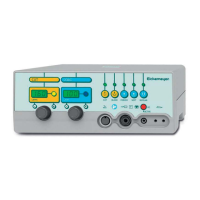EN‐22
MA510a_EN
Instruction’sManual
HFElectrosurgicalinLaparoscopy
Sinceitsintroductionminimallyinvasivesurgeryhasrevolutionizedsurgical
operation offering any significant benefits to the patient of faster healing
and less postoperative pain. In laparoscopy the monopolar HF electro
surgery is the most used because it is highly versatile (pure cut,
coagulation, blended cut that combines these two functions), but this
modalitycancompromisepa
tientsafetybyburns.
The constricted view of the surgical field, the poor maintenance of the
laparoscopic instrumentation, interference on the video monitor, the
insufficient training of the surgeon or his inattention, the smoke, the
insulation failure, the capacitive currents, the contact of the tip of the
active electro
de with the surrounding tissue, these are all factors that
increasethehazardofburns,intra‐abdomenlesions,necrosisofthetissue,
perforationofinternalorgans.Thenatureofthesurgicalenvironment–in
which the active electrode is in close proximity to other conductive
instruments and to tissue‐ may make th
e electrical currents transmission
tounseentissueoffthelaparoscope,causingunintentionaltissueburnsat
non‐targetedsites,by:
- directcoupling
- insulationfailure
- capacitivecoupling
Direct coupling occurs when the active electrode touches another metal
instrument,transferringelectricalcurrenttoitandpossiblyinjuringtissue
withwhichitcomesinco
ntact(forexamplebowelorotherorgans).
Insulation failure occurs when there is an excessive voltage, abuse, wear
andtear,poorhandling,ormechanicalaccidentoftheelectrodeshaftthat
happensduringasinglelaparoscopicprocedureorduringdisinfectionand
sterilization procedures. The breakdown along the un
seen shaft of an
activated electrode can allow electrical current to leak into surrounding
non‐targeted tissues, causing unobserved damage. Paradoxically, small
cracksaremoredangerousthanlargebreaksbecausethecurrentismore
focused,andisthereforemorelikelytoproduceburns.
Capacitive coupling occurs when electrical current is induced from the
active electro
de to nearby conductive material, despite intact insulation.
During HF electrosurgical operations the rapidly varying electrical field
around the active electrode is only partially impeded by electrical
insulationandcreatesstrayelectricalcurrentsbyalternatelyattractingand
repellingions in surrounding bodytissue. Currentstransferredin this wa
y

